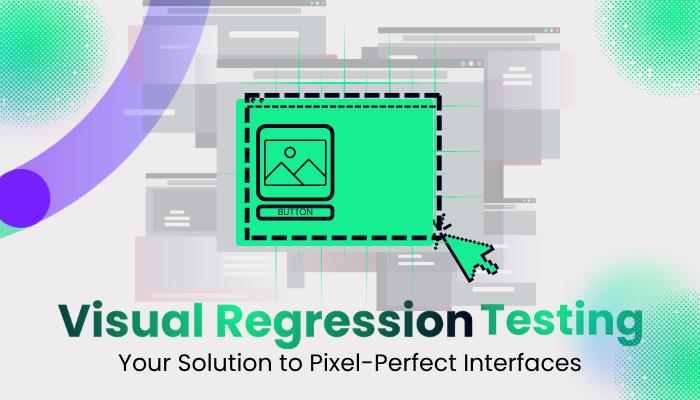You’ve refined your design, checked responsiveness, and double-checked your CSS. Everything seems flawless on your staging environment. But the moment your site goes live, things fall apart-margins collapse, images overflow, buttons disappear on mobile. Sound familiar?
Getting the code right is one thing. Keeping the interface visually consistent across deployments is an entirely different challenge. With so many devices, browsers, and screen sizes to account for, even the smallest tweak in your UI can lead to unexpected changes-ones that silently slip through and go unnoticed until a user points them out.
Visual regression testing was created to prevent this exact frustration. It’s a practical, automated way to catch pixel shifts and layout glitches before your audience sees them.
Let’s explore how this method can deliver consistent, error-free interfaces-every single time.
What Is Visual Regression Testing?
Visual regression testing is a quality assurance process that captures screenshots of your UI and compares them to a baseline reference. It highlights visual differences down to the pixel level, allowing you to detect even subtle changes before they’re released.
It’s essentially a visual version of a unit test. While functional testing confirms whether your code works, visual testing confirms whether your design and layout look exactly as intended.
This is especially useful for:
-
UI components shared across pages
-
Pages with dynamic layouts
-
Sites that undergo frequent style changes
-
Teams practicing CI/CD with rapid deployments
The power of visual regression testing lies in its ability to bridge the gap between code stability and user-perceived quality.
Why Code Passes But Interfaces Break
A common frustration for developers and testers alike is when functional tests pass with flying colors, yet the UI breaks post-release. This happens because functional tests don’t catch visual changes.
Here’s why it happens so often:
-
CSS side effects: A small style update in one part of the app affects unrelated areas.
-
Responsive quirks: Elements shift or resize poorly on certain viewports.
-
Content overflow: Dynamic data (like translated text or longer names) breaks the layout.
-
Third-party scripts: Ads, embeds, or A/B testing scripts introduce visual instability.
You can’t write unit tests to check if a button is 3 pixels too low. But a visual diff test will catch that in seconds.
Key Benefits of Visual Regression Testing
Beyond catching pixel shifts, visual regression testing brings deeper benefits to your development and QA process.
Improved Confidence in Releases
When each visual change is reviewed and verified, your team can ship updates with peace of mind. There’s less second-guessing and fewer last-minute fixes.
Faster Debugging
Visual diffs point directly to what changed and where, drastically cutting down the time it takes to diagnose layout bugs.
Reduces Human Error in Manual QA
Even the best QA testers miss things. Automated visual checks never blink, never get tired, and never skim over subtle issues.
Saves Time in Large Projects
As your app grows, so does the surface area of possible visual breakage. Visual regression testing helps scale QA without overloading your team.
When to Use Visual Regression Testing in Your Workflow
Visual testing shouldn’t be treated as an optional enhancement-it’s a proactive safeguard against UI regressions.
Best moments to implement include:
-
During feature branch development
-
Before merging a pull request
-
After styling refactors or global CSS changes
-
Prior to major version releases
-
When introducing new breakpoints or responsive elements
Incorporating it early saves hours of rework and prevents embarrassing bugs in production.
Must-Have Features in a Visual Regression Tool
Not all tools offer the same capabilities. Depending on your needs, here are key features that matter most:
Pixel-Level Comparisons
A strong tool should detect even the tiniest visual shifts, including padding changes, font shifts, and element misalignment.
Baseline Image Management
The tool must store visual baselines, let you update them selectively, and avoid replacing them accidentally with flawed changes.
Multi-Viewport Support
Testing across desktop, tablet, and mobile is essential for ensuring responsive consistency.
CI/CD Integration
Whether you’re using Jenkins, GitHub Actions, or CircleCI, a good visual regression tool should seamlessly plug into your pipeline.
Clear Visual Diffs
Tools should offer side-by-side comparisons, highlighting exactly what changed, and allowing quick approvals or rollbacks.
Popular Tools to Try for Visual Regression Testing
There’s no shortage of visual regression tools, but some stand out due to reliability and ease of integration.
-
Percy: Excellent for GitHub workflows, CI integration, and visual dashboards.
-
Applitools Eyes: AI-powered detection to reduce noise and highlight meaningful changes.
-
BackstopJS: Highly configurable and open-source-ideal for dev-heavy environments.
-
Chromatic: Tailored for component-based UI development using Storybook.
-
VisualReview: A collaborative, team-friendly tool for visual comparison reviews.
Each tool caters to different workflows. Your choice depends on team size, tech stack, and how deeply you want to integrate visual checks.
Best Practices for Effective Visual Regression Testing
To get the most value from your visual tests, it’s not just about the tool-it’s how you use it.
Here’s what helps ensure efficiency:
-
Test high-value pages first – Homepages, checkout flows, and login screens deserve priority.
-
Use static test data – Avoid unpredictable diffs caused by dynamic or live content.
-
Run tests regularly – Ideally, as part of your build pipeline or nightly runs.
-
Clean up obsolete baselines – Remove unused tests or outdated references to keep your suite lean.
-
Involve designers – Let them review diffs and approve visual changes, especially for sensitive components.
These practices help you build a sustainable, scalable testing process.
Visual Testing in Action: Real-World Examples
Here are a few real scenarios where visual testing saved the day:
-
A fintech dashboard introduced a font-weight change that distorted the balance of spacing. Functional tests missed it; visual diffs caught it.
-
A marketing team updated their global CSS tokens, unintentionally collapsing the mobile navbar. Only visual regression tests flagged the shift.
-
A localization team pushed new German strings that broke responsive containers. The issue appeared only on certain device widths and was quickly detected visually.
The takeaway? Visual issues aren’t rare-they’re just hard to catch without the right lens.
To Wrap Up
A beautiful interface doesn’t stay beautiful by chance. It stays beautiful because it’s protected by smart, automated checks that validate not just functionality, but form. Visual regression testing is your ally in delivering consistent, polished experiences with every release.
It doesn’t replace functional testing-it complements it. And when used properly, it becomes an indispensable part of your QA arsenal.
If You Suffer These Types of Problems in Your Website & You Need Visual Regression Testing…
You can try visual regression testing tools like Percy, Applitools, or BackstopJS,Testevolve . Explore some visual regression testing service provider companies as well-they offer specialized solutions to help you eliminate frustrating UI bugs and deliver a consistent user experience every time.
Read More Blog Posts – Explore Our Website- globalpostnews
- Visual Regression Testing: Your Solution to Pixel-Perfect Interfaces
- Visual regression testing helps maintain pixel-perfect interfaces by identifying unwanted UI changes before they reach your users.
- Visual Regression Testing, Visual Regression Testing Tools
Related posts:
 Understanding the Role of IoT in Modern Manufacturing: A Comprehensive Guide to Smart Factories and Industrial Transformation
Understanding the Role of IoT in Modern Manufacturing: A Comprehensive Guide to Smart Factories and Industrial Transformation
 Smarter Business Networks Start with a Cisco Solution Provider Partner
Smarter Business Networks Start with a Cisco Solution Provider Partner
 Best Account Management Software for All Businesses – EmizenTech
Best Account Management Software for All Businesses – EmizenTech
 Top Remote Tech Jobs for Beginners in 2025 (No Experience Required)
Top Remote Tech Jobs for Beginners in 2025 (No Experience Required)
 The Role of an ATS in Onboarding: Bridging the Gap Between Offer and Start Date
The Role of an ATS in Onboarding: Bridging the Gap Between Offer and Start Date
 Benefits of AI-powered CCTV Cameras for Business Surveillance
Benefits of AI-powered CCTV Cameras for Business Surveillance
 Top App Development Agency UK – Transforming Ideas into Apps
Top App Development Agency UK – Transforming Ideas into Apps
 Solar Power Exford: New Light with Sunshine Restoration Installation Exford
Solar Power Exford: New Light with Sunshine Restoration Installation Exford







